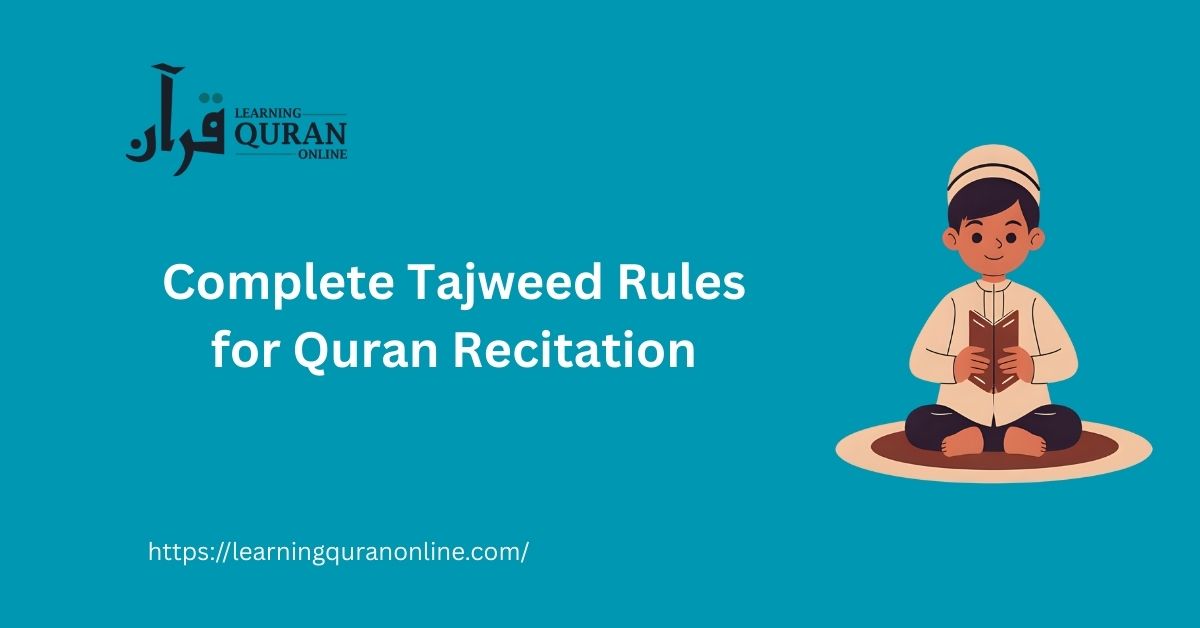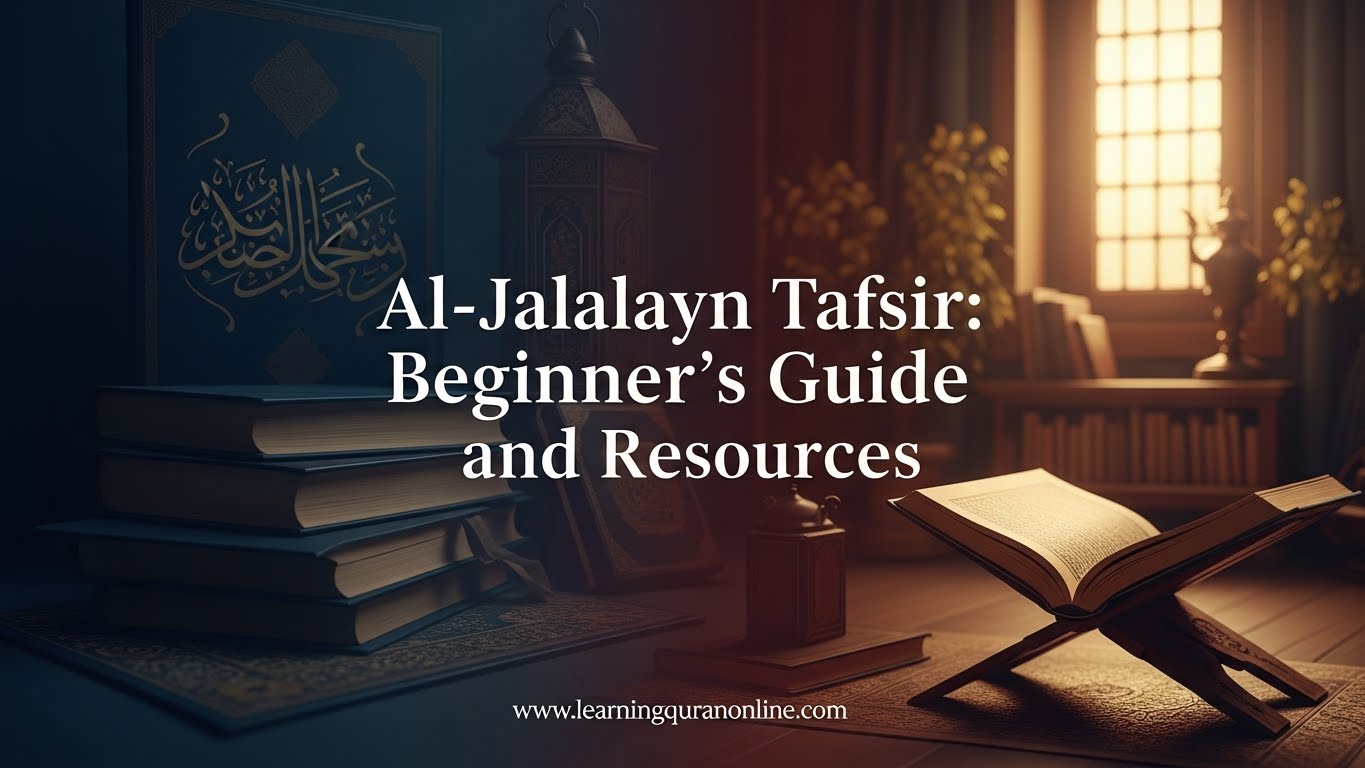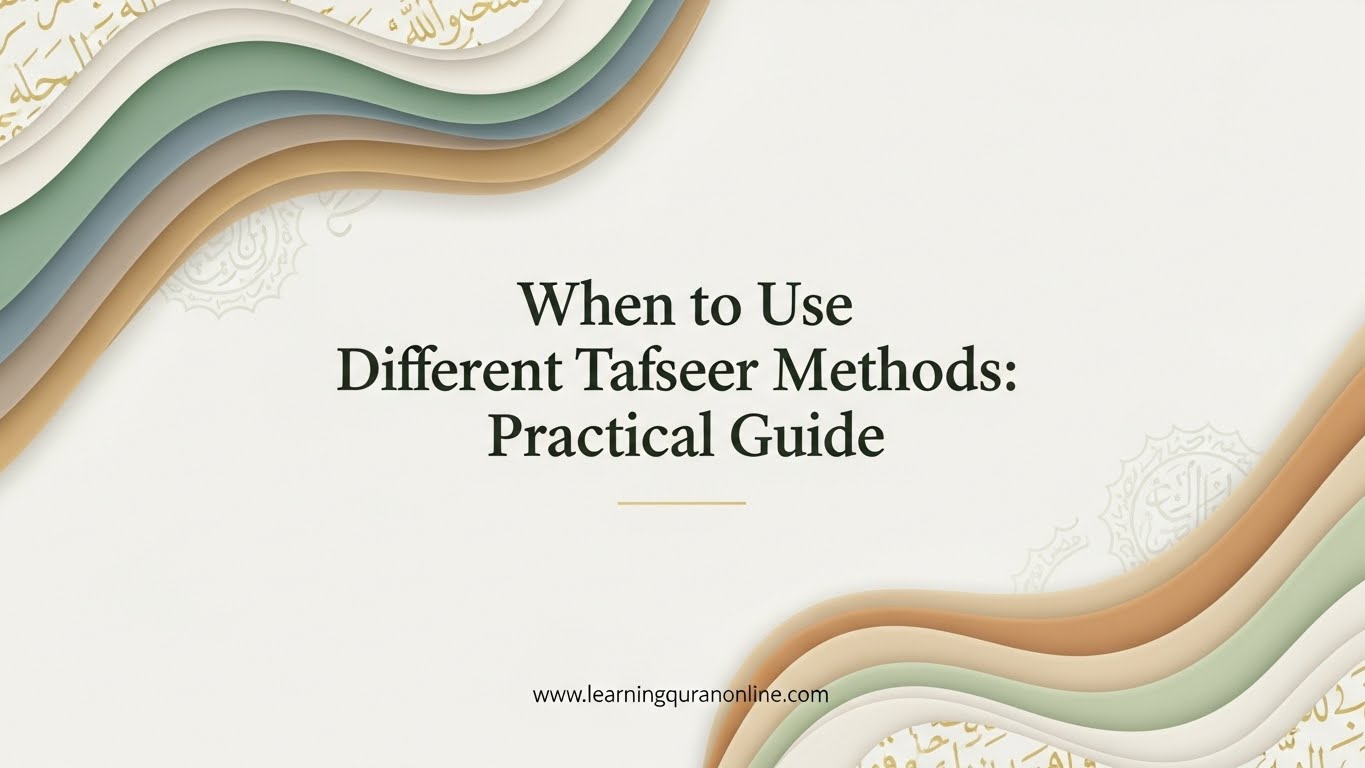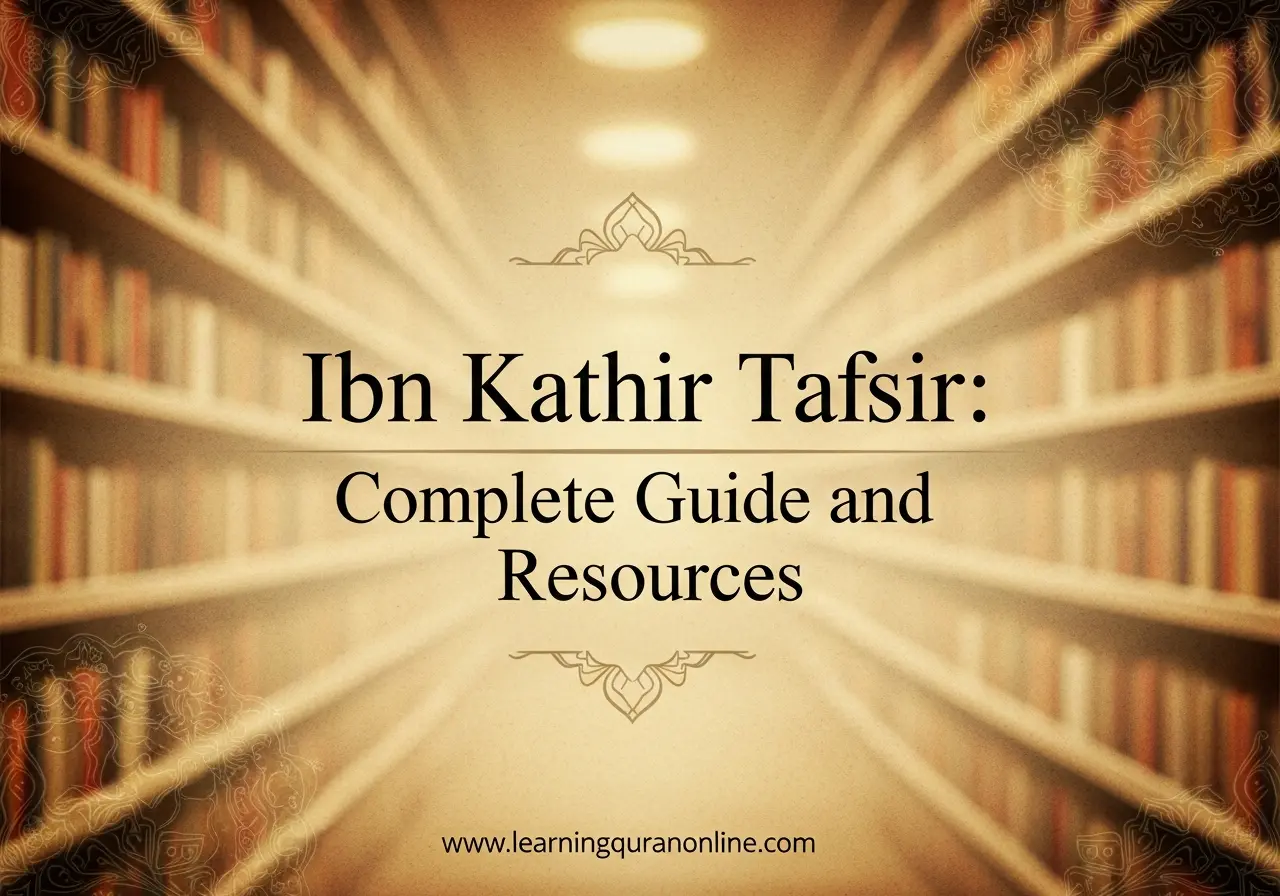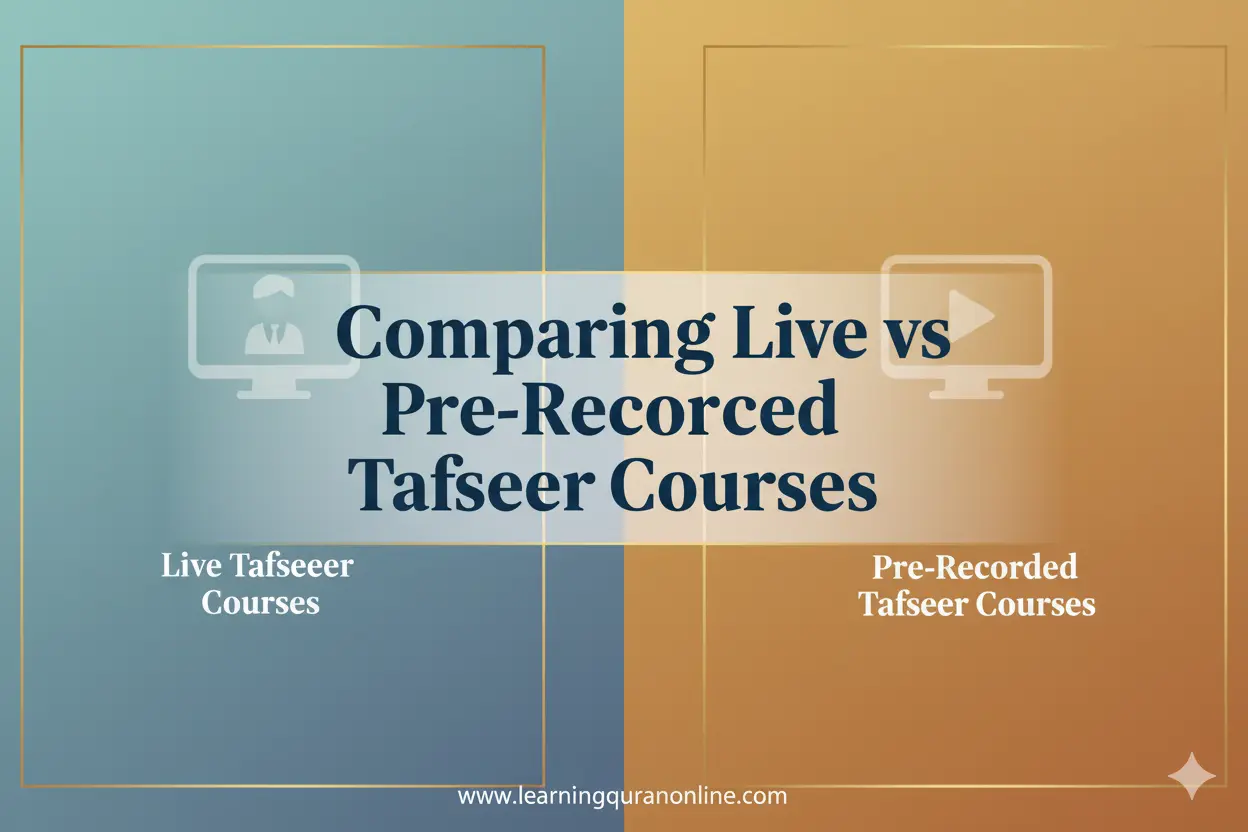Tajweed is the science and art of reciting the Qur’an correctly, following the rules that govern pronunciation, articulation points, and melodic delivery. For anyone who wishes to recite the Qur’an with beauty and precision, understanding the complete Tajweed rules for Quran recitation is essential. Whether you are a beginner or seeking to refine your recitation, this comprehensive guide covers the foundational and advanced tajweed concepts, practical tips, and common mistakes to avoid. If you’re looking for structured lessons, consider joining certified online tutors such as Learning Quran Online for guided tajweed lessons.
Table of Contents
ToggleWhat Is Tajweed and Why It Matters?
Tajweed (تجويد) literally means “to make better” or “to improve.” In the context of the Qur’an, it refers to the rules that ensure each Arabic letter (hurf) is given its due right — a correct articulation point (makhraj), proper characteristics (sifaat), correct elongation (madd), and accurate application of nasalization (ghunnah), stops (waqf), and joins (wasl). Proper tajweed safeguards the meaning, honors the sacred text, and enhances the spiritual and aesthetic experience of recitation.
- Nazra With Tajweed
- Basic Qaida With Tajweed
- Hifz-ul-Quran With Tajweed
- Basic of Islam for the Beginners
- Quran Translation Classes
- Tafseer-e- Quran
Core Components of Tajweed
Tajweed is built on several interrelated components. Mastery of these components enables clear, correct, and melodious Quran recitation:
- Makharij al-Huruf (Articulation points of letters)
- Sifaat al-Huruf (Characteristics or attributes of letters)
- Madd (Rules of elongation/lengthening)
- Ghunnah (Nasalization)
- Rules of Noon Sakinah and Tanween (Izhar, Idgham, Iqlab, Ikhfa)
- Rules of Meem Sakinah (Izhar Shafawi, Idgham Shafawi, Ikhfa Shafawi)
- Qalqalah (Echoing or bouncing sound)
- Hamzatul Wasl and Hamzatul Qat’ (connecting and separating hamzah)
- Waqf and Wasl (Stopping and joining while reciting)
Makharij: Articulation Points of Letters
The starting point for proper pronunciation is knowing the makhraj (plural: makharij) — where each letter emerges from in the vocal tract. Arabic letters originate from the throat, tongue, lips, and nasal cavities. Studying makharij helps prevent common mistakes and ensures every letter is pronounced distinctly and correctly.
Sifaat: Characteristics of Letters
Sifaat are inherent qualities of letters, such as strength (shiddah), softness (rikhawah), breath (hams), echo (qalqalah), and others. Recognizing the sifaat ensures letters are recited with the correct timbre — for example, the difference between heavy letters (tafkhim) like ص and light letters (tarqiq) like س.
Madd: Rules of Elongation
Madd refers to the lengthening of vowel sounds. There are different types of madd that tajweed students must learn:
- Madd Asli (natural madd) — basic elongation of one to two counts.
- Madd Far’i — contextual madds such as madd wajib muttasil, madd jaiz munfasil, madd ‘aridh lil-sukun, and madd laazim. Each has specific conditions and durations (measured in counts: 2, 4, 5, 6, or 8 depending on the school of recitation).
- Madd Munfasil and Muttasil — depending on whether the madd letter and hamzah are in the same word or separated by a pause.
Ghunnah: Nasalization
Ghunnah is a nasal sound that must be held for approximately two counts in letters like م and ن when they are stated as ghunnah (e.g., in idgham bil-ghunnah or when noon is shaddah). Mastering ghunnah produces a resonant and correct recitation, particularly in tajweed rules for noon and meem.
Rules of Noon Sakinah and Tanween
Noon Sakinah (نْ) and Tanween (ً ٍ ٌ) have four main rules — Izhar, Idgham, Iqlab, and Ikhfa — which dictate how the noon sound behaves before different letters:
- Izhar (clear pronunciation): Pronounce noon clearly when followed by throat letters (hamzah, haa, ayn, ghayn, kha, haa).
- Idgham (merging): Merge the noon into certain letters such as ya, ra, mim, lam, waw, and nun (depending on the madhhab and recitation method), sometimes with ghunnah and sometimes without.
- Iqlab (conversion): Change noon sakinah or tanween into a meem sound before the letter baa, with ghunnah.
- Ikhfa (concealment): Partially hide the noon sound with a nasalized, midway articulation before certain letters (15 letters of ikhfa).
Rules of Meem Sakinah
The meem sakinah (مْ) has three main rules:
- Izhar Shafawi: Clear pronunciation of meem before most letters.
- Idgham Shafawi: Merge meem into meem when followed by a shaddah meem (i.e., mimic a doubled meem).
- Ikhfaa Shafawi: Conceal the meem sound slightly before the letter ب (baa), producing a nasalized sound similar to ghunnah.
Qalqalah: The Echoing Sound
Qalqalah is an echoing or bouncing sound produced with particular consonants when they are in a state of sukoon (no vowel) or at the end of a word on a stop. The qalqalah letters are ق ط ب ج د. When pronounced correctly, qalqalah gives a crisp, distinct “bounce” that prevents letters from being swallowed or mispronounced.
Hamzah: Hamzatul Wasl and Hamzatul Qat’
Hamzatul Wasl (the connecting hamzah) is not pronounced when joining from a previous word but is pronounced when starting from that word. Hamzatul Qat’ is always pronounced whether you start or join. Understanding the difference is vital for correct wasl and proper tajweed application.
Waqf and Wasl: Stopping and Joining
The rules of waqf (stopping) and wasl (continuing) affect pronunciation, madd application, and meaning. Proper stopping avoids changing the meaning and observes the orthographic and tajweed signs. Examples of important stops include:
- Waqf Lazim (obligatory stop) — where pausing changes meaning if not observed.
- Waqf Ja’iz (permissible stop) — stopping is allowed but not necessary.
- Wasl — connecting words smoothly without unnecessary pauses; appropriate madd and hamzah rules apply during wasl.
Practical Tips to Learn Tajweed Effectively
Learning tajweed combines knowledge and practice. Here are actionable methods to improve:
- Start with makharij and sifaat: Spend time with a teacher to identify articulation points using mirrors and phonetic demonstrations.
- Listen to skilled qaris: Repeatedly listen and imitate renowned reciters to internalize rhythm and tajweed rules.
- Practice slowly and deliberately: Break verses into small segments, master them, then increase speed.
- Record and compare: Record your recitation and compare with a precise model to identify errors.
- Use tajweed books and apps: Many resources explain madd, ghunnah, and stops with audio and visual aids.
- Take structured lessons or a tajweed course: Guided tajweed lessons accelerate learning, provide feedback, and correct subtle mistakes.
Common Mistakes to Avoid
Beginners and even intermediate reciters often make these recurring mistakes:
- Merging letters incorrectly (wrong idgham or izhar).
- Neglecting makharij, causing mispronunciation (e.g., confusing ح and ه).
- Improper application of madd lengths, leading to incorrect meaning or melody.
- Overlooking ghunnah or holding it too long; timing is essential.
- Stopping at the wrong place, changing the meaning of a verse.
Tajweed for Different Learners: Kids, Adults, and Advanced Students
Tajweed teaching should be tailored. For children, use visual aids, songs, and repetition. Adults benefit from systematic learning, phonetic explanations, and focused practice. Advanced students should study variant qira’at (recitation methods), maqamat (melodic modes), and deeper phonological nuances. Regardless of age or level, consistent practice and feedback are indispensable.
Finding the Right Tajweed Teacher or Course
When choosing a tutor or course, look for certified instructors who emphasize both theory and practice. A strong tajweed teacher will correct makharij, demonstrate sifaat, provide audio assignments, and explain waqf/wasl. Online tajweed programs, live one-on-one lessons, and small-group classes offer flexible ways to learn tajweed rules for beginners and advanced learners alike.
Conclusion: Recite with Confidence and Respect
Mastering the complete Tajweed rules for Quran recitation is a journey that combines linguistic skill, musicality, and reverence. By learning makharij, sifaat, madd, ghunnah, and the rules for noon and meem, you can recite with clarity, protect the meanings of the Qur’an, and experience deeper spiritual connection. Start with the essentials, practice consistently, seek qualified teachers, and use modern tools like tajweed apps and online courses to reinforce your learning. With patience and dedication, perfecting tajweed is within reach for every sincere learner.
Ready to begin or improve your tajweed journey? Seek structured tajweed lessons, practice regularly, and apply these rules gradually — your recitation will become more correct, melodious, and meaningful over time.

